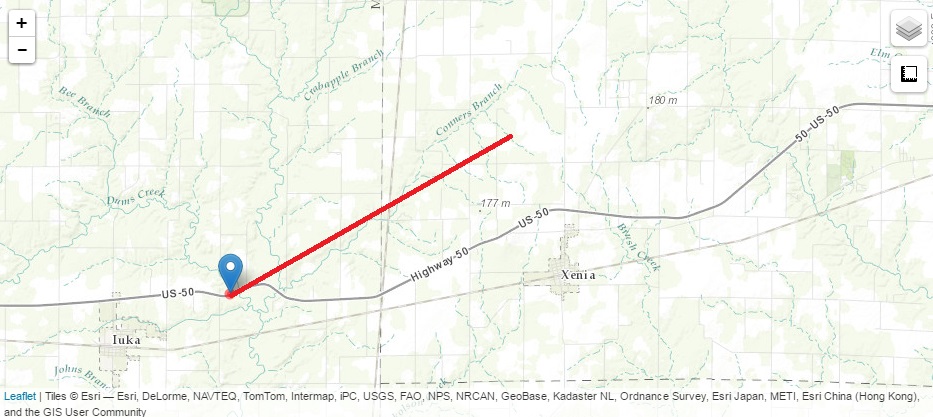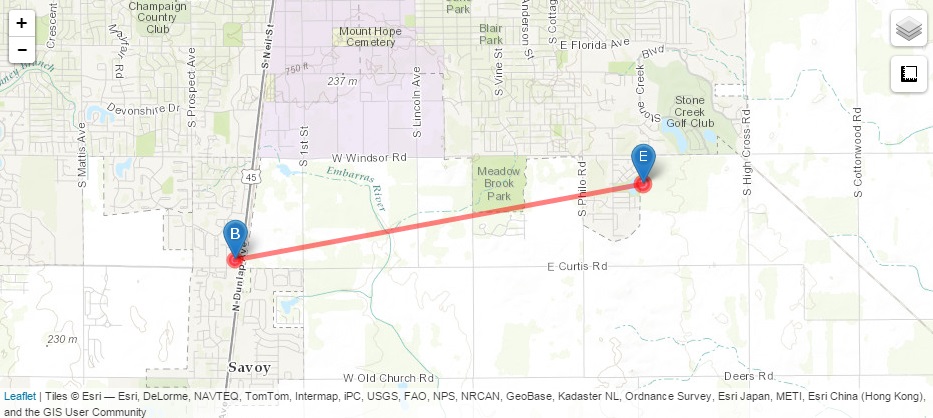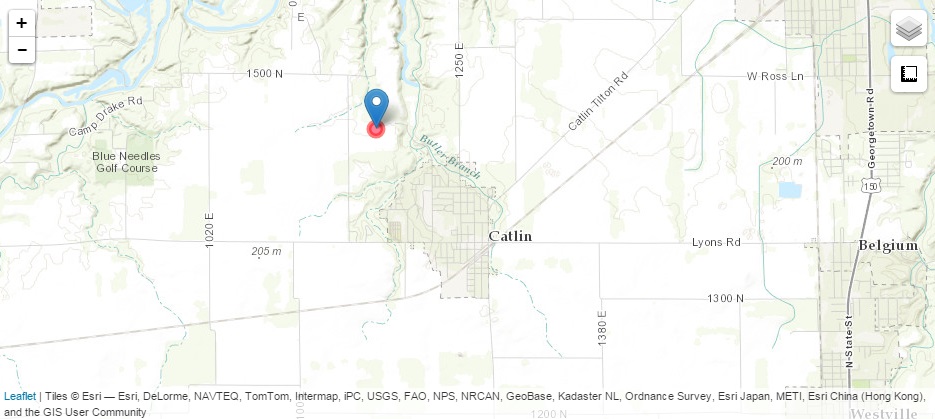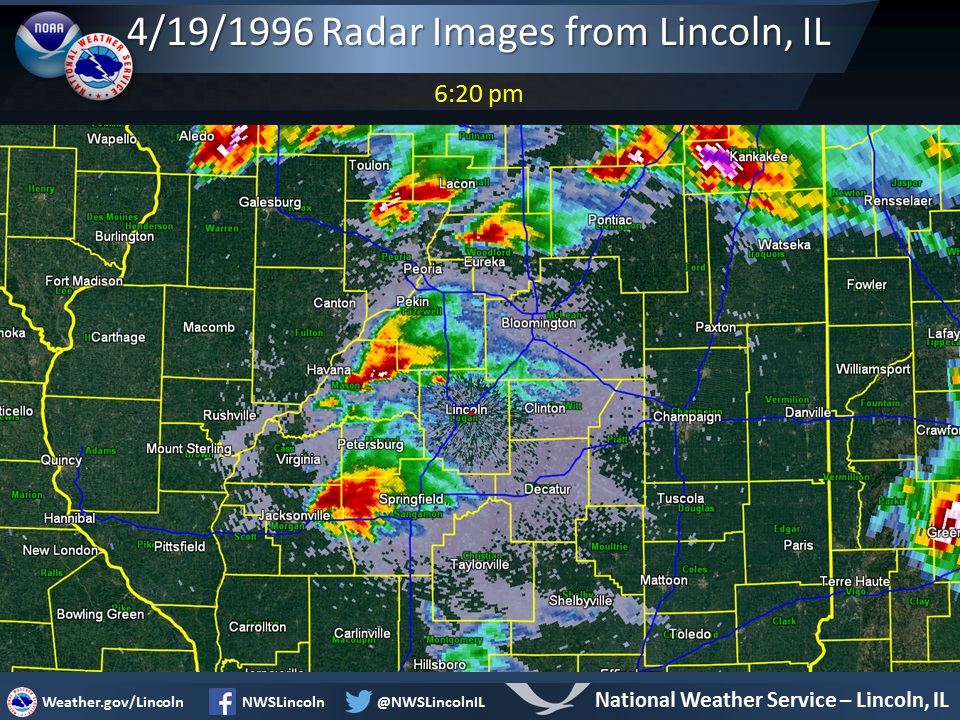Overview
|
On April 19, 1996, Illinois experienced its largest tornado outbreak on record to date. A total of 39 tornadoes were observed across the state. (The record was surpassed on July 15, 2024, when 49 tornadoes occurred.) One particular supercell in central Illinois was responsible for producing 10 tornadoes. It included an F2 strength tornado in Jacksonville, as well as F3 strength tornadoes in Decatur, Champaign/Urbana, and Ogden. Decatur had also been struck by a tornado the evening before. Overall, there were 74 injuries in central Illinois, with one fatality, and damage estimates were in excess of $100 million. This particular page reviews the 19 tornadoes that occurred in the area covered by the Lincoln NWS. |
 Tornado reports from 7 am April 19 to 7 am April 20 |
Tornadoes:
A total of 19 tornadoes occurred in the area covered by the Lincoln NWS.
Track maps show the approximate path.
|
Tornado #1 - 3 miles north of Mattoon
Track Map 
|
||||||||||||||||
|
Tornado #2 - 3 miles north of Fairgrange
Track Map 
|
||||||||||||||||
|
Tornado #3 - 3 miles northwest of Paris to 3 miles north of Paris
Track Map 
|
||||||||||||||||
|
Tornado #4 - 2 miles north-northwest of Paris to 2 miles north of Paris
Track Map 
|
||||||||||||||||
|
Tornado #5 - 5 miles west-southwest of Winchester to 3 miles west-southwest of Winchester
Track Map 
|
||||||||||||||||
|
Tornado #6 - Bath to 1 mile east of Havana
Track Map 
|
||||||||||||||||
|
Tornado #7 - 1 mile southwest of Brimfield to 3 miles northeast of Brimfield
Track Map 
|
||||||||||||||||
|
Tornado #8 - 2 miles west-southwest of Easton to 7 miles northeast of Easton
Track Map 
|
||||||||||||||||
|
Tornado #9 - 2 miles east of Jacksonville to 1 mile north of Orleans
Track Map 
|
||||||||||||||||
|
Tornado #10 - 2 miles east of Alexander
Track Map 
|
||||||||||||||||
|
Tornado #11 - 2 miles east of New Berlin to 5 miles east-northeast of New Berlin
Track Map 
|
||||||||||||||||
|
Tornado #12 - 3 miles north-northeast of Union to 4 miles west of Funks Grove
Track Map 
|
||||||||||||||||
|
Tornado #13 - 2 miles south-southwest of Niantic to 3 miles northeast of Decatur
Track Map 
|
||||||||||||||||
|
Tornado #14 - Milmine
Track Map 
|
||||||||||||||||
|
Tornado #15 - 3 miles south of Monticello to 2 miles southeast of Monticello
Track Map 
|
||||||||||||||||
|
Tornado #16 - 11 miles east of Salem to 3 miles north-northwest of Xenia
Track Map 
|
||||||||||||||||
|
Tornado #17 - Savoy to Urbana
Track Map 
|
||||||||||||||||
|
Tornado #18 - 1 mile southwest of Ogden to 1 mile north-northeast of Ogden
Track Map 
|
||||||||||||||||
|
Tornado #19 - 1 mile northwest of Catlin
Track Map 
|
||||||||||||||||
The original Fujita Scale was in use during the time of this event. It classified tornadoes into the following categories:
| F0 Light 40-72 mph |
F1 Moderate 73-112 mph |
F2 Significant 113-157 mph |
F3 Severe 158-206 mph |
F4 Devastating 207-260 mph |
F5 Incredible 261-318 mph |
 |
|||||
Radar:
The Doppler radar at Lincoln had only been in operation for about a year at the time of this event, and was officially commissioned in January of that year.

Radar image from 6:20 pm, showing 4 separate supercells over central Illinois
Click here for animated radar loop (3.0 MB).
 |
 |
Left: Radar image from 5:45 pm, with the storm north of Winchester. A hail spike is shown by the light reflectivities extending southwest through Detroit to just south of Pittsfield, indicating large hail. Right: Dual-panel image from 5:57 pm of reflectivity (left) and storm relative motion (right) products with the tornado near Bath. A strong circulation is shown on the right panel, indicated by the pink and light blue/green shades coming together. |
 |
 |
Left: Dual-panel image from 6:09 pm of reflectivity (left) and storm relative motion (right) products of the supercell near Brimfield, shortly before it produced a tornado. Right: Also at 6:09 pm, the supercell near Jacksonville was showing signs of rotation (right panel, green shades against red/pink areas). A tornado would touch down about 9 minutes later. |
 |
 |
Left: Dual-panel image from 6:20 pm of reflectivity (left) and storm relative motion (right) products of the Easton tornado. The hook echo over Easton (left panel) and strong circulation (right panel) are clearly visible. Right: From 7:13 pm, the tornado in southwest McLean County is shown by the strong circulation in the right panel (pink shades against green/blue shades). |
 |
 |
Left: At 7:25 pm, a tornado was moving through the Harristown area, having touched down a few minutes prior. Right: Radar image from 8:58 pm, shortly after a tornado exited Ogden. Due to the distance from the radar, the lowest level circulation is not visible, but rotation is still quite evident at the height of the radar beam (6200 feet), seen by the red and green shades together just northwest of Fithian. |
Additional Information
Other Reports
Large hail and strong winds accompanied these supercells. Some of the other reports received as a result of these storms:
| Time | Location | Report |
| 4:47 pm | Newman (Douglas Co.) | 2 inch diameter hail |
| 4:58 pm | Brocton (Edgar Co.) | Several windows blown out of a home |
| 5:04 pm | Toluca (Marshall Co.) | Marble to golf ball size hail fell for over 30 minutes |
| 5:10 pm | Paris (Edgar Co.) | Golf ball size hail |
| 5:20 pm | 5 miles north of Paris (Edgar Co.) | Several windows blown out of a home |
| 5:25 pm | Astoria (Fulton Co.) | Golf ball size hail |
| 5:30 pm | 4 miles south of Knoxville (Knox Co.) | Golf ball size hail |
| 5:47 pm | 1 mile north of Winchester (Scott Co.) | Power pole snapped in half |
| 5:48 pm | Winchester (Scott Co.) | Golf ball size hail |
| 6:38 pm | Delavan (Tazewell Co.) | Golf ball size hail, and numerous power lines blown down |
| 7:17 pm | Illiopolis (Sangamon Co.) | Semi-trailer blown over on I-72 due to strong winds |
| 8:26 pm | Flora (Clay Co.) | Several trees and power lines blown down |
| 8:30 pm | Champaign (Champaign Co.) | Golf ball size hail |
| 8:34 pm | Savoy, Willard Airport (Champaign Co.) | 75 mph wind gust |
| 8:58 pm | 3 miles northwest of Olney (Richland Co.) | Strong winds blew apart a trailer |
| 8:58 pm | Teutopolis (Effingham Co.) | Strong winds blew down a tree onto a car, causing 1 injury |
How have things changed since 1996?
| Item | How it was done in 1996 | How it is done now |
| Issuing severe weather warnings | Radar data was analyzed on two large monitors, using a tablet and mouse. When a warning was needed, the forecaster went to a separate workstation to create the warning. The computer program filled in some of the warning, but large parts of it had to be manually inserted. | Radar data is analyzed on the same workstation that is used to review other weather data. When a warning is needed, the warning creation software (which is also on the same workstation) is used to "draw" the area in danger. A few mouse clicks are used to select the hazards (e.g. 70 mph winds, golf ball size hail, etc.). With this, a fully formatted warning is assembled in a minute or less. |
| NOAA Weather Radio | NWS staff manually recorded each message, using 8-track tapes. As there were 3 separate stations, updates could be delayed as separate messages had to be created for each station. Up to 8 messages could be included in each broadcast. | A computer automatically processes forecasts, weather bulletins, and observations, and uses a synthesized voice to create broadcasts for all 9 stations operated by the office, with room to expand. There is no limit to the number of messages included in each broadcast. |
Summaries from other NWS Offices
 |
Media use of NWS Web News Stories is encouraged! Please acknowledge the NWS as the source of any news information accessed from this site. |
 |